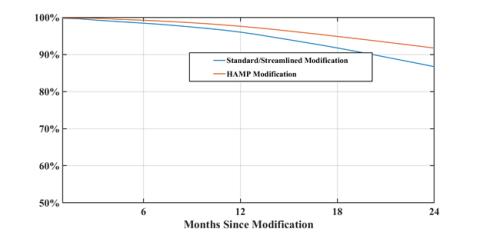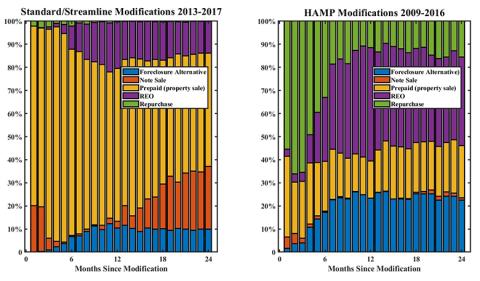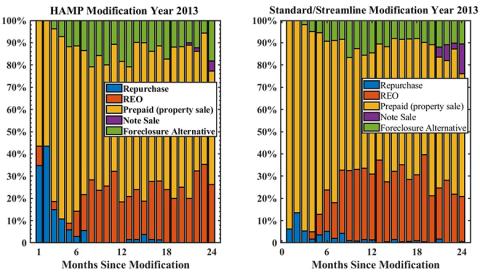This blogpost offers a potential measure of the effectiveness of two retired Fannie Mae and Freddie Mac (the Enterprises) loan modification programs: the Home Affordable Modification Program (HAMP) and the Standard/Streamlined modification program.i The first section of the blog discusses the two modification programs, introduces the concept of post-modification homeownership longevity, and shows that both programs successfully helped borrowers remain in their homes during the two years following modification. The second section looks more closely at how homeownership can end when the loan is liquidated. Liquidation outcomes and home retention differ across the modification programs; however, the program outcomes align when the analysis focuses on a common modification year with similar mark-to-market loan-to-value (MTM LTV) ratios.
A loan modification is a private contract between the borrower and the servicer to change the mortgage terms. Modification programs change the terms of the mortgage by adjusting the interest rate, maturity term, and in special circumstances, the principal balance of the loan. Ideally, the modified terms of the mortgage should enable the borrower to maintain ownership of their home until they voluntarily sell it.
The analysis includes more than 400,000 loans modified from 2009 to 2017. The data lacks a direct measure of the time a borrower maintains homeownership after the loan modification.ii Homeownership duration is based on whether the loan remains active (not liquidated). The absence of a reported liquidation is indicative of continued homeownership. Figure 1 compares the percent of loans remaining active after a modification. Twelve months after loan modification, 96.6 percent of Standard/Streamlined and 97.7 percent of HAMP modified loans remain active. The rather small 1.1 percentage point difference suggests similar outcomes across the two loan modification programs at the one-year mark. It is also noteworthy that by the end of the second year, 87 percent of the Standard/Streamline loans remain active while 92 percent of the HAMP loans remain active. Both programs demonstrate a reasonably good home retention grade.
Figure 1: Longevity of Modified Loans

This section looks more closely at how homeownership can end when the loan is liquidated. The liquidation outcomes can be generalized into five events: foreclosure alternatives (short sale and deed-in-lieu), loan sales, prepayment, real estate owned (REO), and seller or servicer repurchase.iii Figure 2 illustrates the usage of the five liquidation types in the HAMP and Standard/Streamlined programs, respectively.
Figure 2: Shares of Liquidation Outcomes for Modified Loans

While homeownership ends when the loan liquidates via a foreclosure alternative, or the home becomes REO, it is difficult to tell whether homeownership ends under the three remaining liquidation events: loan sale, repurchase, and prepayment. For a loan sale and a seller/servicer repurchase, the Enterprises transfer the loan out of their retained portfolio to the purchaser or repurchaser. The data does not track these loans once they exit the Enterprises’ portfolio.
Liquidation by prepayment means the borrower either sells the home or refinances it with a new mortgage. The data do not have a flag to determine whether homeowners sold or refinanced their homes. However, recently modified loans will not meet refinance underwriting requirements because the loan experienced at least one 60-day delinquency within the past 12 months. Additionally, it is unlikely that refinancing the loan would be economical to the borrower as the modified mortgage payment would likely be lower than the payment on the new loan, not to mention the refinance transaction fees. It is reasonable to assume modified loans that liquidate by prepayment during the first year after modification are home sales that end homeownership. Liquidation by home sale is a better outcome for the borrower and Enterprises than liquidation by REO or a foreclosure alternative because the borrower receives a payment equal to their home equity net of the transaction cost after the home sale.
As shown on the left side of Figure 2, 75 percent of the liquidated loans ended in prepayment for Standard/Streamlined modified loans during the first year. The fourth month following modification represents the peak in the share of prepayment liquidations at 93 percent. Gradually the share of prepayments decreases to 66 percent of liquidations by the 12th month. The decline in the prepayment share is attributable to increases in REO and foreclose alternative liquidations. In contrast, prepayment is not the dominant liquidation outcome for HAMP loans as shown on the right side in Figure 2. Within the first year after a HAMP modification, 53 percent of liquidations resulted in the loss of homeownership — 34 percent by REO and 19 percent by a foreclosure alternative. Thus, the two modification programs have relatively similar longevity outcomes, but quite different liquidation paths.
The state of the economy in the year of modification and the source of the motivating hardship strongly influence liquidation outcomes across the modification programs. HAMP modifications occurred between 2009 and 2016 while Standard/Streamlined modifications occurred from 2013 to 2017. Table 1 indicates that 40 percent of the HAMP modifications in this sample occurred in 2010 and were likely motivated by the great financial crisis. HAMP modifications in 2010 remain in a state of negative equity on average one year after modification.iv The presence of negative equity greatly restricts the borrower’s ability to sell the home. Meanwhile, the greatest volume of Standard/Streamlined modifications occurred in 2014 and report average positive home equity of 21 percent. The presence of positive home equity enables borrowers facing financial hardships to sell their homes while borrowers with negative home equity cannot pay off the mortgage with the proceeds from the home sale.
Table 1: Modification Program Incidence and LTV

Figure 2 represents short-term modification outcomes for loans modified over the entire life of these modification programs. It is useful to consider the liquidation shares for a single year of modifications to highlight the influence of the economy on the modification outcome. The year 2013 is the first period both programs are simultaneously available and the MTM LTVs twelve months after modification are similar. Figure 3 displays the liquidation shares across both programs for loans modified in 2013. Despite the relatively higher repurchase share following HAMP modification in Figure 3, prepayment (property sale) is the most frequent liquidation outcome across both programs. Within the first year after modification both programs display a similar share (approximately 30 percent) of liquidation by either REO or foreclosure alternatives. Even though the programs’ terms differed, liquidation outcomes are analogous for loans modified in 2013. The state of the economy is an important element in the success of modification programs.
Figure 3: Share of Liquidation Outcomes for Loans Modified in 2013

This blogpost only considers the most simplistic factors toward understanding short-term post-modification longevity and liquidation shares. Evaluating modification programs’ performance is a difficult task because each program must be considered in the context of the current economy. The Enterprises and the Federal Housing Finance Agency (FHFA) continuously evaluate multiple factors toward maintaining modification programs and other loss mitigation options available to borrowers facing financial hardships.
i Borrowers who experience a temporary hardship and are unable to make their scheduled payment are generally placed in forbearance for 3 to 6 months. COVID-19 Forbearance and Disaster Forbearance are not loan modifications.
ii Program descriptions are available at https://www.fhfa.gov/programs/retired-loss-mitigation-solutions.
iii A short sale is when a borrower sells the home for less than the balance remaining on the mortgage. A deed-in-lieu is when a borrower voluntarily transfers ownership of the property to the owner of the mortgage in exchange for a release from the mortgage loan and payments. A loan sale is when the Enterprises sell the modified loan to a private investor. Prepayment refers to when the home is either sold or refinanced. REO refers to when an Enterprise receives the home in exchange for terminating the mortgage at the conclusion of the foreclosure process. A seller or servicer repurchase is when the Enterprises require repurchase because of the violation of representations and warranties.
iv Negative equity is when the unpaid principal balance of the loan is greater than the market value of the home. When the loan-to-value ratio is greater than one, the loan is said to have negative equity.
Tagged: FHFA Stats Blog; GSE; Fannie Mae; Freddie Mac; Government Sponsored Enterprises (GSEs); Home Affordable Modification Program (HAMP); Home Retention Options; Loan Modifications
By: Robert M. Dunsky
Principal Economist, FHFA Division of Research and Statistics